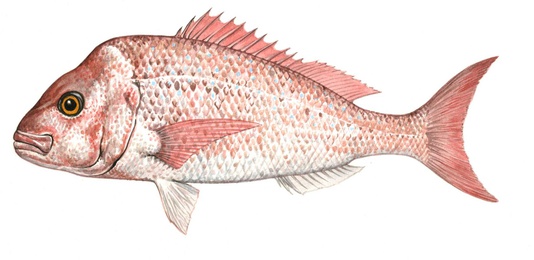Snapper
Chrysophrys auratus

(Image credit: Peter Gouldthorpe, DPIPWE)
No evidence as yet to suggest the species are resident all year round in Tasmania, or that there is any self recruitment within the area. The 'population' is probably a south-eastern Australian one, of which some mobile schools are now ranging further south in summer than previously recorded. Really it appears schools of snapper are now more predictably encountered in northern Tasmania in places, and extending to southern Tasmania when conditions are favourable, particularly in warmer summers. These still seem to be fairly mobile rather than resident, and recruitment of juveniles is still primarily in Victorian waters (Port Phillip Bay, etc) from where they radiate out to places like northern Tasmania as they become bigger. Although snapper are becoming more common on the recreational fishing scene it is still unclear if they are breeding in Tasmania, and even if they are staying for the winters. It is on the Redmap list to begin determining it life cycle and seasonal behaviours, in Tasmania, more closely.Mature snapper are pink and appear to have a convex forehead in larger adults. Juveniles have blue spots over the body. Snapper have strong jaws and dorsal spines capable of breaking off in a wound. They feed on mussels; oysters; fish sea urchins; crabs, prawns and worms.
AKA: Shnapper, cockney bream, red bream, squire
Length: Up to 1.3 m
Habitat
Rocky reefs and estuaries. Juveniles in inlets, bays and other shallow and sheltered marine waters; 1-200 m depth
Log it
In Tasmania, log snapper if you spot it south of Maria Island
In Queensland, log snapper North of Mackay
Related links/info
Species names on the Redmap site are based on the Codes for Australian Aquatic Biota or CAAB (http://www.cmar.csiro.au/caab/). This is updated regularly and lists the approved common name, family, species name and more.
Redmap species descriptions were based, with permission, on the following resources:
Australian Marine Life: The Plants and Animals of Temperate Waters by G. J. Edgar, Revised Ed. (2008) Reed Books, Melbourne
Fishes of Australia’s Southern Coast, Edited by M. Gomon. D. Bray and R. Kuiter (2008) Reed Books, Melbourne
Fishes of Tasmania by P. Last, E. Scott and F. Talbot (1983). Tasmanian Fisheries Development Authority, Hobart
Find further information and images at FISHES OF AUSTRALIA http://www.fishesofaustralia.net.au/











